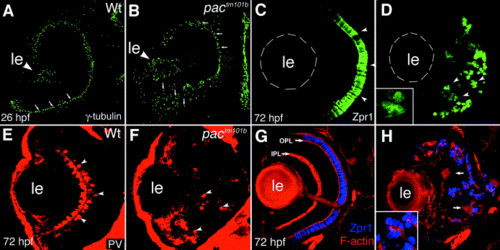Fig. 4
- ID
- ZDB-FIG-080423-8
- Publication
- Malicki et al., 2003 - Zebrafish N-cadherin, encoded by the glass onion locus, plays an essential role in retinal patterning
- Other Figures
- All Figure Page
- Back to All Figure Page
|
Phenotype of the pactm101b mutant allele. pactm101b produces defects in the retinal neuroepithelium and in the organization of retinal neurons. In wild-type retinal neuroepithelium, all centrosomes are positioned apically at 26 hpf (A). By contrast, the centrosomes of pactm101b mutant retina are scattered along the apicobasal axis of the neuroepithelium in the ventral portion of the eye cup (vertical arrows in B), while the dorsal retina appears unaffected (horizontal arrows in B). At 3 dpf, photoreceptor cells of pactm101b mutant animals are scattered throughout most of the retina (arrowheads in D), while their wild-type counterparts form a uniform layer (arrowheads in C). Ectopic photoreceptors adhere to each other forming clusters, rosettes (inset in D). Parvalbumin-positive amacrine cells localize to ectopic positions in pactm101b retina (arrowheads in F). In wild-type zebrafish larvae, these cells form a layer in the center of the retina (arrowheads in E). Neuronal processes of the zebrafish retina form two uniform layers that strongly stain with phalloidin: outer plexiform layer (OPL) and inner plexiform layer (IPL) (arrows in G). In the retinae of pactm101b/tm101b mutants, neuronal processes form disorganized patches instead of layers (arrows in H). The lens, “le”, is outlined with dashes in (C) and (D). All panels show transverse cryosections through the retina stained with the following reagents: anti-γ- tubulin antibody (A, B), Zpr-1 antibody (C, D, G, H), anti-parvalbumin antibody (E, F), and phalloidin (G, H). In all panels, dorsal is up. |
Reprinted from Developmental Biology, 259(1), Malicki, J., Jo, H., and Pujic, Z., Zebrafish N-cadherin, encoded by the glass onion locus, plays an essential role in retinal patterning, 95-108, Copyright (2003) with permission from Elsevier. Full text @ Dev. Biol.

